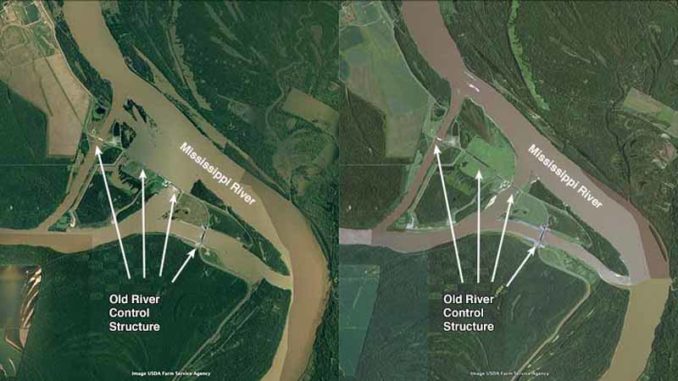
The Old River Control Structure (ORCS), the Army Corps of Engineers’ critical defense against the risk of the Mississippi River undergoing an economically catastrophic change in its course, is under increasing threat due to flood heights that have escalated in recent decades. The higher floods are from increasing sedimentation of the river’s channel. This was due to the construction of the structure, plus other river engineering efforts.
As detailed last week in Part I of this series, America’s Achilles’ Heel: the Mississippi River’s Old River Control Structure, the ORCS was built to act as a bulwark against the Mississippi River’s natural inclination to carve out a new channel to the Gulf of Mexico. The river wants to forge a path down the Atchafalaya River that is half as long and twice as steep as the river’s current channel, which takes it past Baton Rouge and New Orleans. The ORCS consists of four major water control structures which allow no more than 30% of the Mississippi River to flow into the Atchafalaya River: the Low Sill Structure and Overbank Structure (built in 1963), the Auxiliary Structure (completed in 1987), and the Sidney A. Murray Junior Hydroelectric Plant (completed in 1990).
However, the construction of the ORCS is contributing to its potential failure: the Mississippi River is forced to slow down when it reaches the structure, and this slowdown has resulted in the deposition of a prodigious amount of sediment that has clogged up the river’s channel. Additional sedimentation has been caused by the construction of smaller wing dikes that stick out from the river’s banks into the main current (to stabilize the channel and improve navigation safety during low river flows), from armoring of the levee banks with articulated concrete and steel mattress revetments (to prevent erosion of the levees), and from a series of channel modifications done in the 1930s, when necks of 16 meander bends were sliced through to create a shorter path for the river. The net result: higher flood heights due to the clogging of the river channel, which increases the chance of the structure’s failure during a major flood.
By Dr. Jeff Masters, wunderground.com